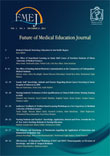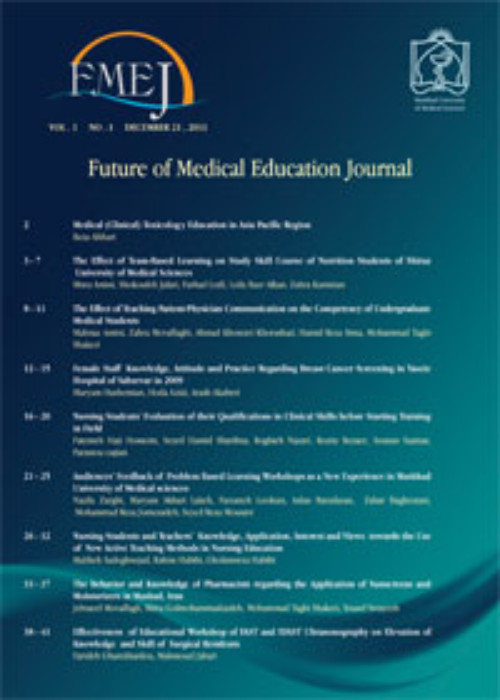فهرست مطالب

Future of Medical Education Journal
Volume:5 Issue: 3, Sep 2015
- تاریخ انتشار: 1394/08/15
- تعداد عناوین: 8
-
-
Pages 42-47BackgroundResearch at undergraduate and graduate level is important in deciding career fields and future profession. The undergraduate studies are greatly enriched by doing research work. This study assess research trends among medical students by evaluating their research career choices, factors influencing their research career preferences and future plans at Jinnah Sind Medical University (JSMU) in Pakistan.MethodsThis study was based on cross-sectional survey in which 256 students were enrolled from 1st to 5th year of medical education.ResultsThe study showed that there was a drastic change in approach to research from higher to lower grades as junior medical students were more interested in research work compared to seniors. It was found that most of the students planned to do both research and clinical practices and least number of students were interested only in biomedical and clinical research as a career choice. Surgery was ranked as the first choice by the students for research followed by internal medicine and gynecology.ConclusionsAccording to this study, Student’s career decision was mainly influenced by the desire of their family. There should be an official research division in every medical college and university to encourage students towards research. It can be concluded that there is yet less inclination of medical students towards research so there is need to facilitate students towards research in medical sciences by mentorship and developing better research infrastructure in medical universities.Keywords: Research, Medical Students, Career Choices, Specialty Preferences, Clinical Research
-
Pages 48-53BackgroundSufficient and thorough knowledge in early recognition of symptoms and proper management of ASD is of utmost importance to medical graduates in the initial years of their learning in medical school. Their knowledge regarding ASD will be helpful when they become health care professionals as it will be easy for proper management of ASD. Our aim is to evaluate and analyze medical undergraduate studentMethodTotal of 221 undergraduate medical students studying in Preclinical, para clinical and early clinical phase of MMMC, participated in this questionnaire based survey study. Close ended questionnaire which was validated and proved to be reliable was given to students to assess their level of knowledge about ASD. Results of data were analyzed using SPSS softwareResultsTotal mean score for the preclinical students was 5.91±2.90, for para-clinical it was 7.30±3.00 and that for clinical year students (students in 3rd year of medical school) it was 9.42±2.20 out of 14. The knowledge about ASD among the students significantly increased alongside their curricular levels (p<0.05).ConclusionsOverall knowledge of medical undergraduate students about the ASD at their preliminary curricular stages is inadequate. But, there was a significant improvement as their curriculum progresses which reflect the academic up gradation among the medical students and their positive attitude towards ASD.Keywords: Autism Spectrum Disorder, Student Perception, Knowledge
-
Pages 54-58Backgrounddevelopment in new changing of training management that emphasizes on using objective methods and more facultie's engagement in students evaluation, were motivation for application tools such as flowchart, checklists and rating scales. This study examined the effectiveness of Performance Rating Tables (PRTs) in evaluation of medical interns in Mashhad, Iran.MethodsInternship Performance Rating Scales were developed based on the curriculum objectives of community medicine internship and implemented within 14 months (2012-2013). At the end of each month student performance assessed based on scores of their PRTs and portfolios. Students filled out a questionnaire about how much PRTs can become familiar with their tasks, changing their knowledge, attitudes, skills and competency in scale score 0-20. Field performance, Engagement, interest and creativity of students were assessed in Likert scale.ResultsThe mean score of Intern's performance evaluation were 6/7±0/9 from totally 8. In students opinion the mean score of the effectiveness of PRTs was 18±1/8 and their competency was 17/4±0/9. Females compared with male got higher score to the effectiveness of the PRTs and own competency, (P =0/005, 0/04). There were significant correlation between PRTs and student's performance in view of health center supervisors and Intern's self-evaluation scores (P <0/05).ConclusionsThis study showed that PRTs are effective tools for the field training management and targeted evaluation of medical interns in the department of community medicine.Keywords: Evaluation, Medical Intern, Checklist, Performance Rating Table, Engagement
-
Pages 59-63BackgroundContinuing Medical Education (CME) of general practitioners (GPs) regarding most of the diseases, especially psychiatric disorders, is implementing worldwide to maintain and develop their knowledge, skills, and professional performance. We investigated the effects of CME on GPs knowledge in the field of psychiatric disorders in Dezful University of medical sciences (DUMS) as a Newly Established University.MethodsAmong the 300 volunteers of GPs affiliated to DUMS in autumn 2013, 86 of them were randomly selected to attend in continuing psychiatric education schedule. A self-administered questionnaire was prepared by consultation of six psychiatrists and its validity and reliability was assessed. GPs knowledge before and after CME training session were evaluated by this questionnaire. Data analysis was performed using, inferential tests such as Pearson and Spearman correlation coefficient test and also, ANCOVA and paired t-test were used. Data were analyzed with using statistical software SPSS 18.ResultsThe results showed that there is a significant difference (P < 0.01) at the mean scores of GPs knowledge before and after training in the fields of psychiatry. Moreover, it was indicated that although subject`s knowledge is acceptable about psychiatry, but precise continuing education courses could improve their knowledge significantly (P< 0.01).ConclusionsCME significantly improves GPs knowledge in psychiatric disorders area especially in less developed regions and medical center with limited scientific resources. Therefore, implementing this type of trainings in regions which are potentially similar to our study area could be very useful.Keywords: Continuing Medical Education (CME), General Practitioners (GPs), Psychiatry, GP's Knowledge
-
Pages 64-68BackgroundConsidering the occurrence of medical emergencies in dental practice, and the essential need of acquiring competency in Basic life support (BLS), the aim of the present study was to evaluate the effect of BLS workshop on the skills of dental students in the cardiopulmonary resuscitation.MethodsIn this switching replication experimental study, students in the 5th year of Mashhad dental school (Iran) in 2013 participated in the study. All participants completed a baseline assessment at the skill lab (pre-test). To evaluate the practical skills of students in the cardiopulmonary resuscitation, a scenario was presented, and the students were asked to demonstrate all the actions that are necessary to rescue the patient on a manikin. A trained instructor scored their skills according to a standard checklist. Then; the participants were randomly divided into two groups. The first group took BLS workshop and was assessed immediately after the workshop (immediate post-test), while final examination was conducted one month after the course. The same scenario was used for all participants at each testing point. In the second group, the second pretest was taken within one month of the first pretest. Immediately after taking the second pretest, the students participated in workshop, and were assessed immediately after the course. To compare the score of competency in BLS in the two groups, t-test or Mann-Whitney U-test was used.ResultsPrimary skills of the two groups were almost similar (P= 0.77). Considerable increase in the skills of the two groups was observed after taking the workshop. One month interval between the two pretests in the second group did not cause any significant difference in the student's skills (P = 0.12). A decrease was observed in the skills of first group one month after the first exam (P = 0.003).ConclusionsBLS workshops can significantly increase dental students’ competency in life support. However, considering the retention time of skills, refreshing courses are strictly recommended.Keywords: Cardiopulmonary Resuscitation, Education, Skills, Students
-
Pages 69-73Backgroundclinical education with patient-focused learning is very important in medical education. Therefore, it is very essential to select an appropriate education method. The current study was conducted to analyze the impact of simultaneous presentation of medical stager and inter in seminars provided with a pre-organizer strategy and from the student's perspective (2012-2013).Methodsthis is a semi-experimental study with post-test method for a group of students. The student's perspective was evaluated via a questionnaire (including four arenas) designed by the researcher, after educating with seminar method and in the end of four semesters. The study population included stagers and interns studying during the four semesters. 33% of the students (36 people) were female and 70 students were male (66%).Resultsthe results presented that 57.7% of the students believed this method enhanced team-working, and 67.9 % believed it activated the students. 89.6% declared this method upgrades learning and 50.9% mentioned that it organized and categorized the information in student's mind. In total, 70.8% of the students preferred this method to other methods. There was no significant relationship between average, age, gender and grade with student's perspective in relation with the influence of this method in organizing information, increasing learning, activating students, and enhancing team-working. (P>/05)Conclusionsaccording to the results, this method in recommended and it upgrades the quality of clinical education.Keywords: Education Quality, Seminar, Pre, organizer, Infectious Disease Ward
-
Pages 74-78BackgroundPain alleviation and its prevention is one of the nursing priorities. Morbidity and mortality, time of hospitalization and its cost diminished by adequate pain management. according to the importance of innovative educational method, the current study conducted.MethodsThis quasi-experimental study conducted on under-teaching nursing students at Zabol and Zahedan College. 60 students were divided in two groups that include 30 persons in each. Data of knowledge and attitude was collected by a reliable questionnaire in two stages, before and after training. Data was analyzed with SPSS software.ResultsIn total, average ages of students were 21.48 ±1.74 years, 24 males and 36 females. As sequent, Knowledge and attitude average score in two group before intervention were 18.33 ±3.47 and 83.98 ±5.63, respectively. This score changed to 28.27 ±2.67 and 99.25 ±5.39 after training. Independent sample T-test showed no significant difference between average score between two groups (P>0.05). Paired T-test showed significant difference between average score in knowledge and attitude before and after intervention (p<0.001).ConclusionsThere was no difference between the web-based group and the lecture group in knowledge and attitude scores regarding pain management. It is shown that this approach was not dominant to others. In addition, our finding showed scores of knowledge and attitude in post training were more before intervention that emphasized both training approach were effective for enhancing pain management.Keywords: Lecture, Electronic Educational Approach, Pain Management, Nursing Student, Attitude, Knowledge
-
Pages 79-82BackgroundE-Learning could be increases efficiency of teaching process and higher quality of education. The aim of this study was to determine the factors related to eLearning intention based on the Adoption Technology Model (ATM).MethodsThis cross-sectional study, conducted among 150 faculty members of Kermanshah University of medical science. Participants were randomly selected to participate voluntarily in study and filled out a self-administered questionnaire. Data were analyzed by SPSS-21 using appropriate statistical tests including t-test, ANOVA, Pearson correlation and linear regression at 95% significant level.ResultsThe ATM predictor variables, accounted for 46% of the variation in the outcome measure of the eLearning intention. Furthermore, eLearning intention have a correlation with attitude (r=0.464), perceived ease of use (r=0.353) and external variables (r=0.308).ConclusionsBased on our findings, it seems in designing intervention for encouraging faculty members to E- Learning teaching should be more attention to attitude, perceived ease of use, and external variables.Keywords: Adoption Technology Model, E, Learning Intention, Faculty Member


